July 28, 2022
Personalization Engines: Definition, Use Cases & Examples
By Liza Colburn

Savvy consumers expect some degree of personalization in their shopping experience. They might want you to remember the last item they bought, suggest a complementary product, or to offer a loyalty discount based on their purchase history.
Keeping up with these expectations is nearly impossible without technology. Humans just aren’t able to monitor thousands of data points every day and use them to create a better customer experience. That’s why personalization engines are so important for e-commerce businesses.
In this post, we’ll cover what personalization engines are, how they function, and share some examples of how they’ve helped companies reach their goals.
What Is a Personalization Engine?
A personalization engine is software that analyzes customer behaviors across different channels to serve up relevant content. (That’s the simple definition — we’ll explain later in this post what personalization engines can do).
Personalization AI “learns” from user behavior and creates new iterations of content to improve engagement with customers and site visitors. It understands how to motivate not just customer segments, but also individuals. A personalization engine is like a data scientist — only exponentially faster!
Customer Data Platforms (CDPs) vs. Personalization Engines: What’s the Difference?
A personalization platform tracks the behavior of customers, as well as unknown — or lookalike — consumers. The data a personalization engine collects is exclusively for marketing purposes.
A CDP analyzes the behavior of existing customers only for purposes beyond marketing. For example, a CDP might gather information from software customers to gauge how to improve the user interface.
How Does a Personalization Engine Work?
A personalization engine is powered by artificial intelligence that continually learns from human behaviors to predict user actions or offer relevant content. For example, a personalization engine may know that a website visitor has previously viewed sleeping bags for sale. When that user returns to the same website, a personalization engine may recommend related products, such as a tent, backpack, or sleeping pad.
What Can Companies Do With Personalization Engines?
Here’s what companies can do when they use personalization engines:
Satisfy customer expectations
Your repeat customers expect you to know what they like. A personalization engine can show customers products that are relevant to their interests, whether that’s on your website or in their social media feeds.
Increase customer engagement
The right words make all the difference when trying to capture the attention of customers and persuade them to take action. A personalization engine outperforms humans in creating a click-worthy message.
Case study: charity: water Increased Customer Engagement by 147%
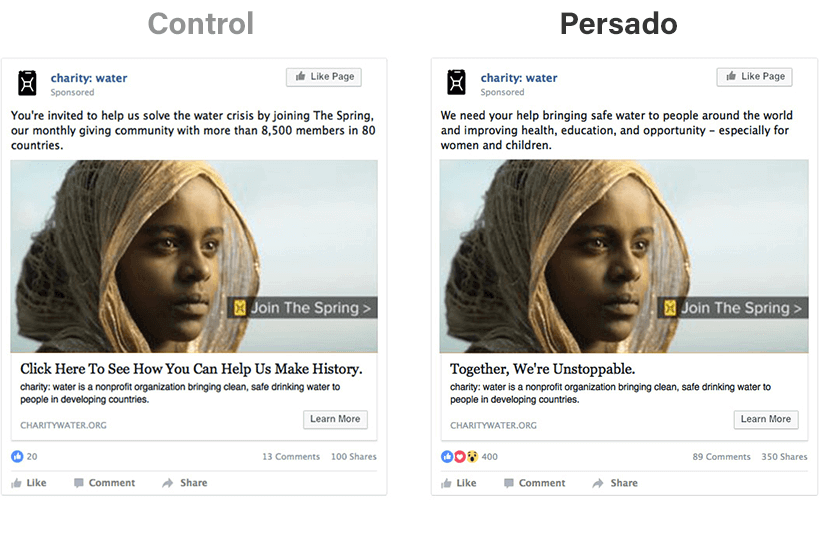 In an effort to attract new donors, charity: water partnered with Persado to launch 16 AI-driven Facebook ads. Persado’s personalization engine fine-tuned ads based on a variety of demographics, getting results that would’ve taken months with traditional A/B testing.
In an effort to attract new donors, charity: water partnered with Persado to launch 16 AI-driven Facebook ads. Persado’s personalization engine fine-tuned ads based on a variety of demographics, getting results that would’ve taken months with traditional A/B testing.
Boost conversion rates
Personalization engines can analyze data to determine which emotional appeals — conveying a sense of urgency or exclusivity, for example — are most likely to increase conversions.
Case study: Vodafone Raised Conversions +42% with AI-Driven Personalization
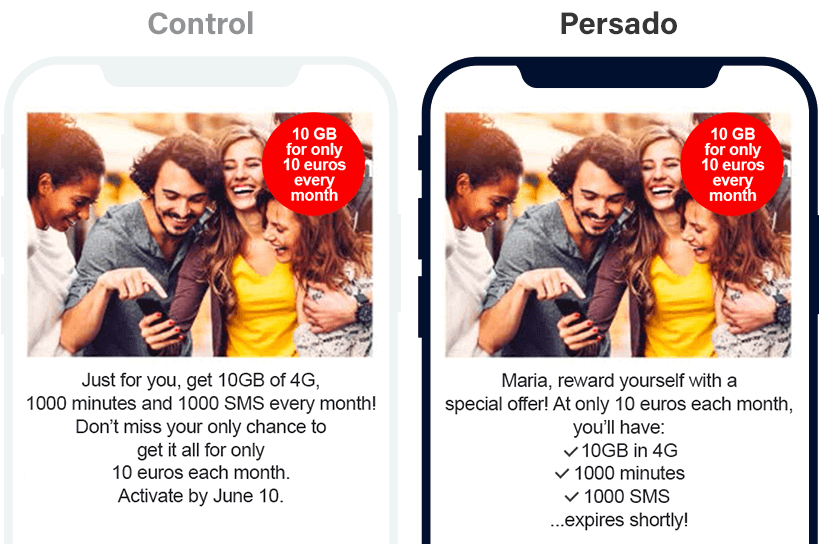
Italian telecom company Vodafone partnered with Persado, seeking to bring back former customers and retain existing customers. Persado analyzed the SMS text that Vodafone’s team created and found four key values that were motivational for customers: intimacy, excitement, achievement and safety. Vodafone saw a 42% increase in its conversion rate, thanks to Persado.
Increase average order value
Getting customers to your e-commerce site is a good goal, but ultimately, you want them to buy your products. A personalization engine can determine what language turns a “window-shopper” into a paying customer, and what motivates them to put extra items into their carts.
Case study: Styleable Increased Order Rate by 112%
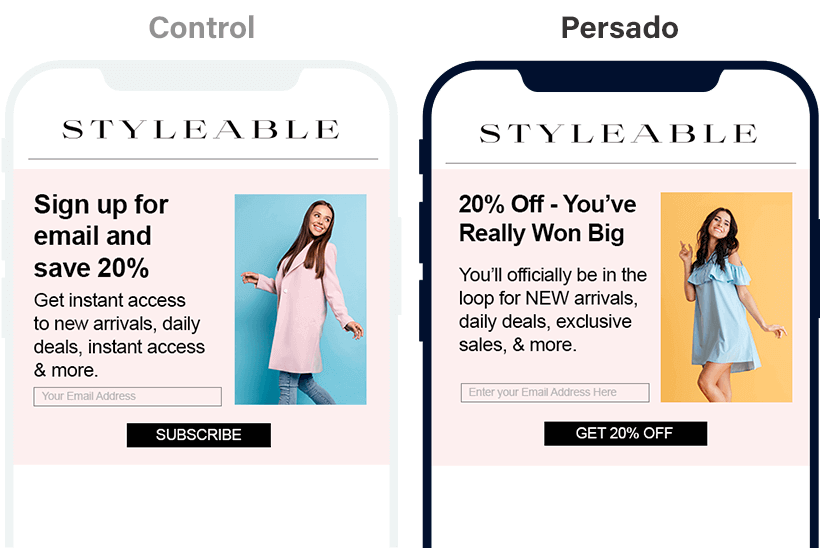
Global clothing retailer Styleable was looking for a way to catch the attention of new shoppers and increase the average order value. Analyzing 2,048 message permutations, Persado found that headlines with emotional language increased sign-ups 72%. Persado’s persuasive AI language improved CTAs and connected with site visitors on an emotional level to increase order rates by 112%.
Improve customer retention
Often, marketers think of customers as a single group, but every customer has unique needs. A personalization engine can help you improve customer retention by using the right words to appeal to individual customers, as well as segments.
Optimize the customer experience
A personalization engine helps your customer support team by analyzing customer behavior and serving up relevant content. For example, if a customer is having trouble with the e-commerce checkout process, personalization AI could launch a chat window and attempt to resolve the problem without involving any human agents.
Key Considerations When Choosing a Personalization Engine
Several types of personalization engines are available on the market today, but they don’t all have the same features. When choosing a personalization engine solution for your business, look for the following features:
Customer data ingestion
Data is the fuel for a personalization engine, so when reviewing any platform, make sure it can ingest data from a variety of platforms, and in multiple formats. For example, you may need a personalization engine that can mine data from Facebook and Twitter and combine it with data from your CRM platform.
Level of personalization
Some personalization engines only enable targeting by segment or user group. A true 1:1 personalization engine analyzes the actions of every individual who visits your site — browsing history, device type, and more — to offer dynamic, highly relevant content at each visit.
Testing capabilities
Testing is not a one-and-done task — or at least it shouldn’t be. Look for a platform that allows for incremental multivariate testing, so you can test each part of a message or post. For example, you may want to test different colors, images, wording, or CTAs, and you can’t test all of those at the same time.
Supported channels
Depending on the type of business you have and your customer base, you may need to personalize the user experience across many channels: text message, live chat, email, and your mobile app. Make a list of all channels you currently use, as well as those you may begin using, to help guide your search for a personalization engine.
Examples of Personalization Engines
Now that we’ve covered the advantages of personalization engines and what to look for when shopping for one, let’s take a look at some of the leading personalization engines.
Persado
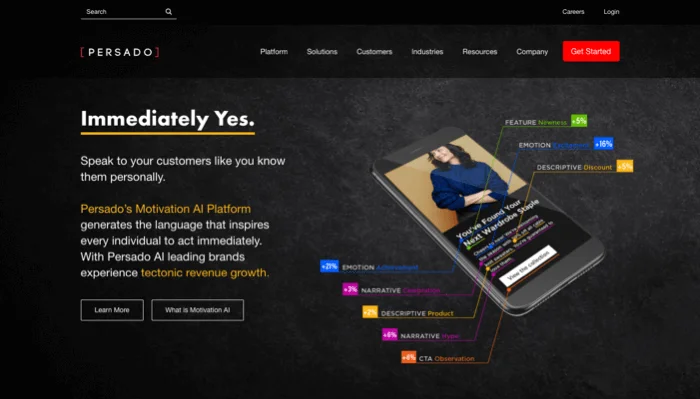 Primary use case: Language personalization at scale
Primary use case: Language personalization at scale
Notable brands: Humana, American Express, Expedia, Verizon, JPMorgan Chase, Dropbox
Persado is a motivation AI platform, meaning its strength is in inspiring people to take immediate action. Along with its patented algorithms and decision engine, the platform is able to interpret the intent of messages and learn different consumer response patterns. Persado uses this insight to continually refine language and deliver personalized communications at scale.
Persado’s personalization engine works across multiple platforms, with the seamless integration you need to pull customer data from several sources. With each ensuing customer action, Persado becomes even better at understanding what motivates every individual and creating the best content to spur conversions.
Vue.ai
 Primary use case: E-commerce store personalization
Primary use case: E-commerce store personalization
Notable brands: ThredUp, Diesel
Vue.ai is a tool that continually improves the user experience for online stores. It can gather an impressive amount of data points that it uses to display products for individual customers — for example, showing a repeat customer a garment in their favorite color, with their favorite neckline, in a fabric that they’ve bought before.
Dynamic Yield
 Primary use case: Triggered messaging
Primary use case: Triggered messaging
Notable brands: MediaMarkt, Bild Shop
Dynamic Yield emphasizes its rules-based and behavior-triggered messaging as a main selling point. While this is a useful feature, it does require administrators to define what the rules and triggers are and create the logic in the messaging sequence. In some cases, it may be necessary to manually schedule push notifications.
Kibo
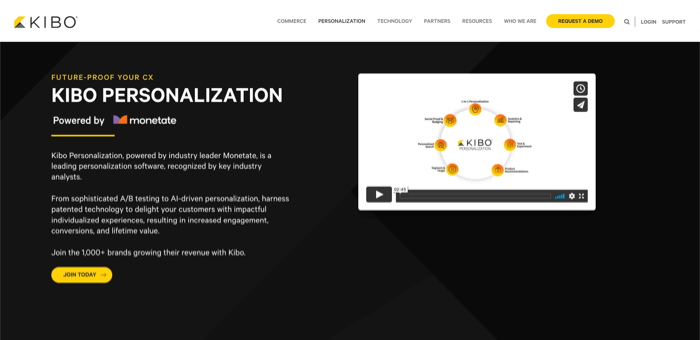 Primary use case: Personalized e-commerce searches
Primary use case: Personalized e-commerce searches
Notable brands: Wrangler, Subaru, Jelly Belly
Kibo’s personalization engine learns from every user search on its site and pulls data from other platforms to know what a user might be searching for. Then it auto-suggests results, helping users find (and purchase) products quickly.
Unlock True Language Personalization at Scale
A/B testing just doesn’t give you the data you need to create compelling content and increase conversions. Persado digs deeper, testing thousands of connections between words, images, demographics, and channels to create deeply motivational content. That’s why Persado’s top 30 customers have seen $1.5 billion in incremental revenue.
Are you ready to see how true AI language personalization — scalable across multiple platforms — can help you reach your goals? If so, it’s time to try Persado.


